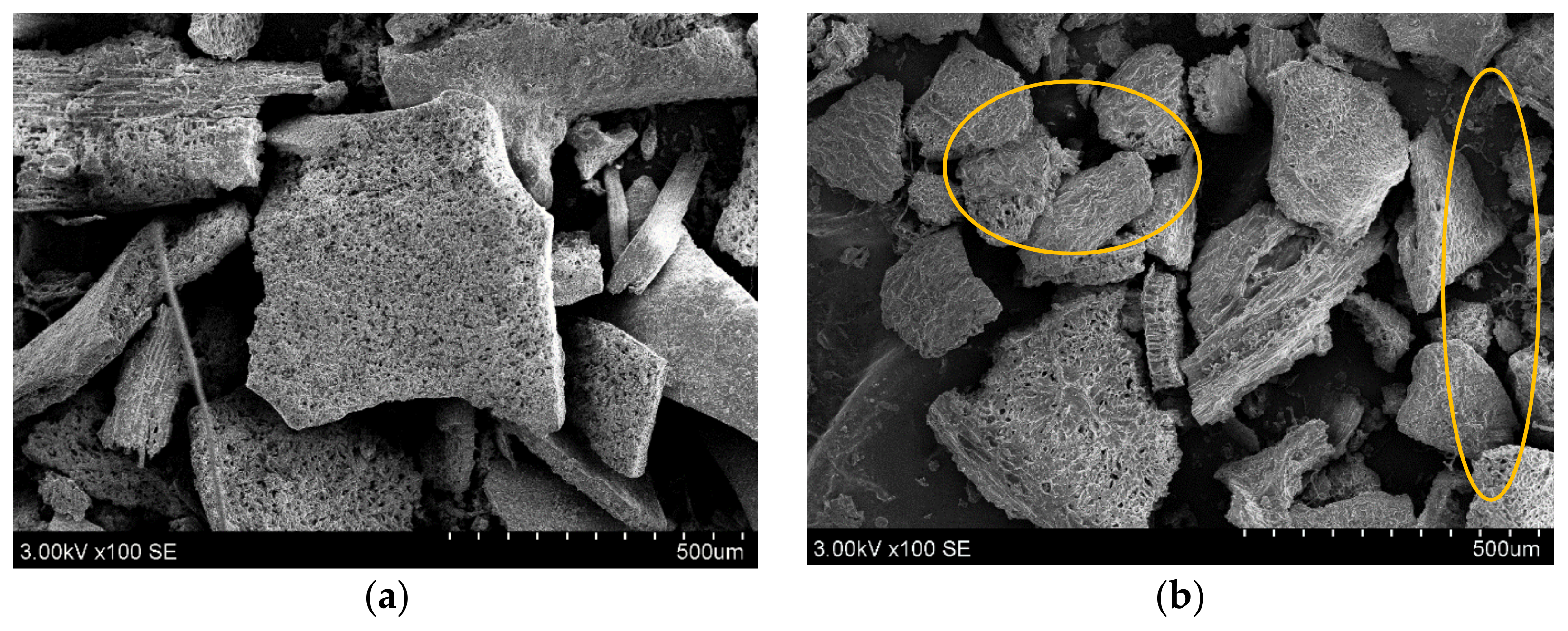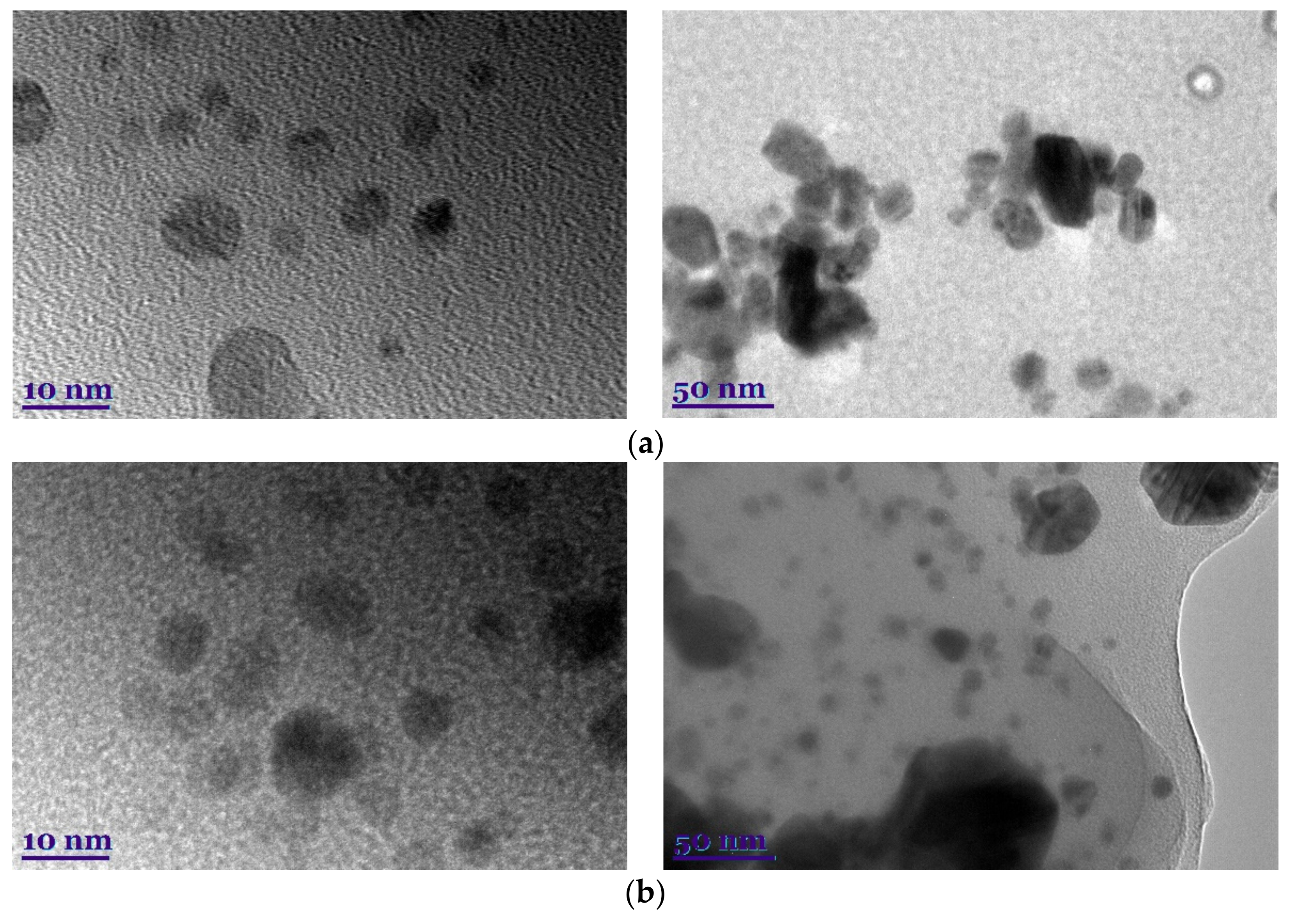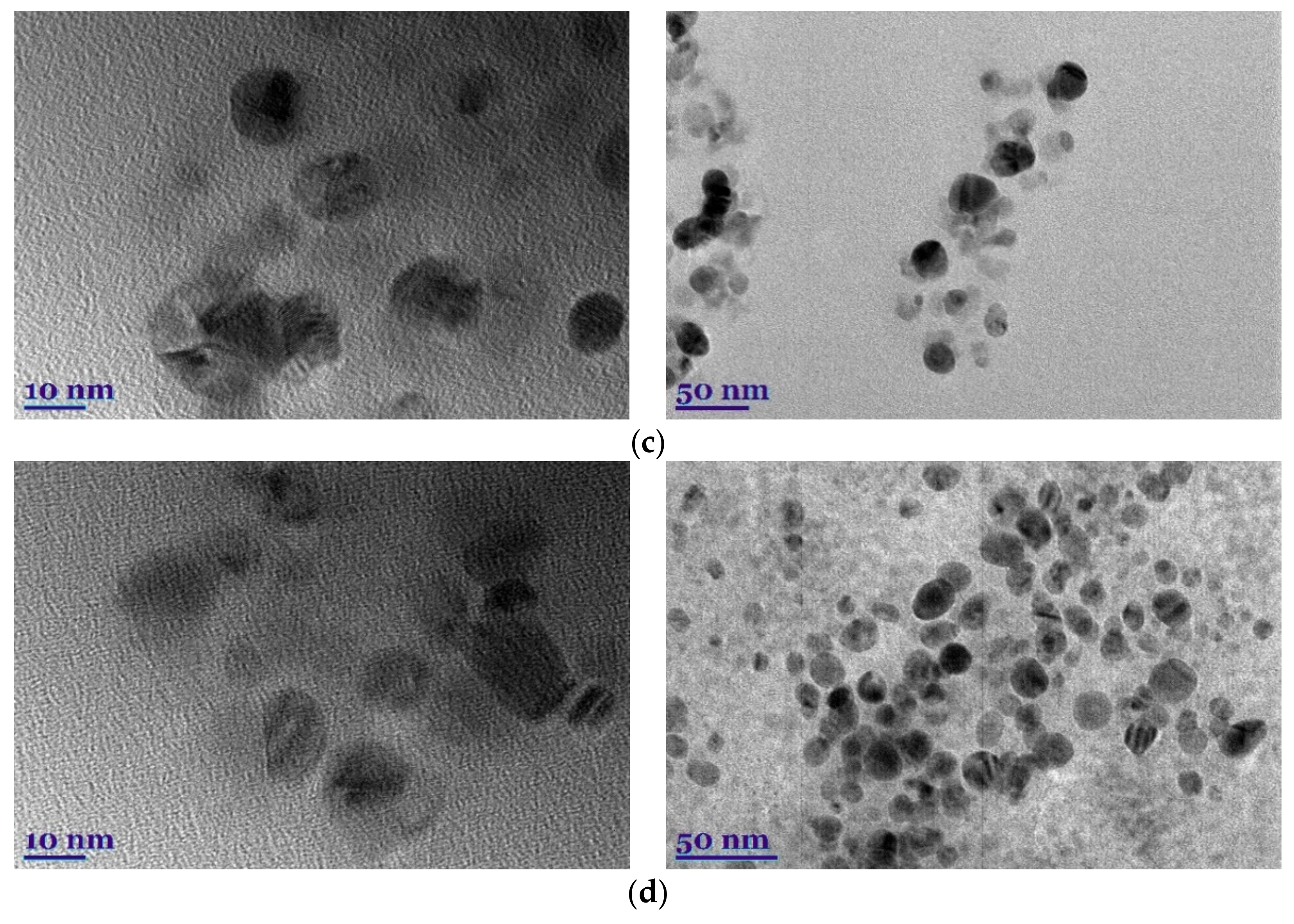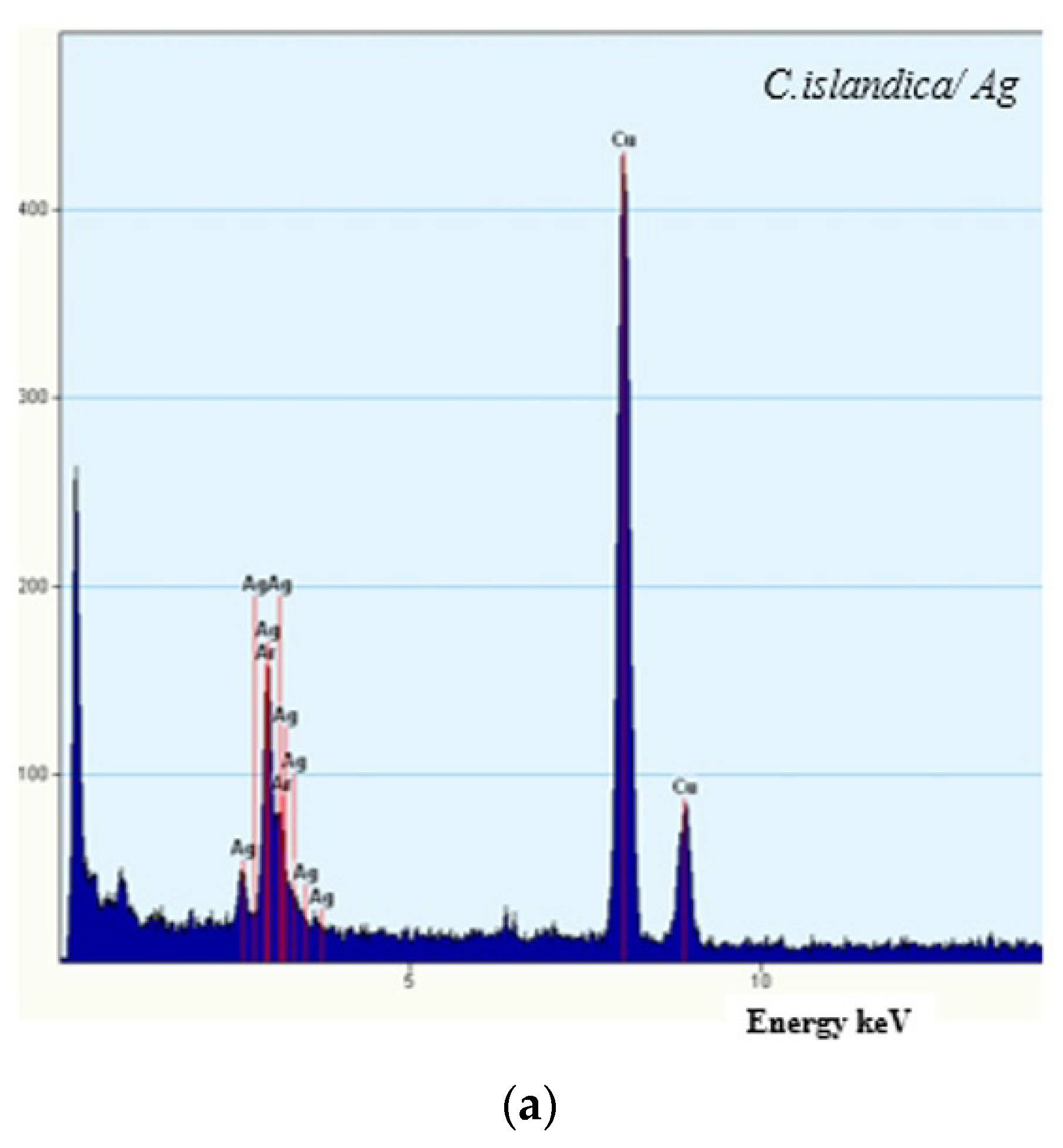Antimicrobial Activities against Opportunistic Pathogenic Bacteria Using Green Synthesized Silver Nanoparticles in Plant and Lichen Enzyme-Assisted Extracts
Abstract
:1. Introduction
2. Materials and Methods
2.1. Lichen and Plant Materials
2.2. Enzyme-Assisted Extraction
2.3. Preparation of AgNPs
2.4. Spectrophotometric Studies
2.4.1. Color Measurement and Active Acidity (pH)
2.4.2. Fourier Transform Infrared (FTIR)
2.5. Microscopy
2.6. Analysis of Total Phenolic Compounds
2.7. In Vitro Antioxidant Activity Assays
2.8. Antimicrobial Activity
2.9. Statistical Analysis
3. Results and Discussion
3.1. Color Measurement, Active Acidity and Sugars
3.2. Morphological Analysis
3.2.1. Scanning Electron Microscopy (SEM)
3.2.2. Transmission Electron Microscopy (TEM)
3.3. Fourier Transform Infrared (FTIR)
3.4. Total Phenolic Content and In Vitro Antioxidant Activity
3.5. Antimicrobial Activity
4. Conclusions
Author Contributions
Funding
Institutional Review Board Statement
Informed Consent Statement
Data Availability Statement
Acknowledgments
Conflicts of Interest
References
- Pandiyan, N.; Murugesan, B.; Arumugam, M.; Sonamuthu, J.; Samayanan, S.; Mahalingam, S. Ionic Liquid—A Greener Templating Agent with Justicia Adhatoda Plant Extract Assisted Green Synthesis of Morphologically Improved Ag-Au/ZnO Nanostructure and It’s Antibacterial and Anticancer Activities. J. Photochem. Photobiol. B Biol. 2019, 198, 111559. [Google Scholar] [CrossRef] [PubMed]
- Hassan, K.T.; Ibraheem, I.J.; Hassan, O.M.; Obaid, A.; Ali, H.H.; Salih, T.A.; Kadhim, M.S. Facile Green Synthesis of Ag/AgCl Nanoparticles Derived from Chara Algae Extract and Evaluating Their Antibacterial Activity and Synergistic Effect with Antibiotics. J. Environ. Chem. Eng. 2021, 9, 105359. [Google Scholar] [CrossRef]
- Lagashetty, A.; Ganiger, S.K. Synthesis, Characterization and Antibacterial Study of Ag–Au Bi-Metallic Nanocomposite by Bioreduction Using Piper Betle Leaf Extract. Heliyon 2019, 5, e02794. [Google Scholar] [CrossRef] [PubMed] [Green Version]
- Balwe, S.G.; Shinde, V.V.; Rokade, A.A.; Park, S.S.; Jeong, Y.T. Yeon Green Synthesis and Characterization of Silver Nanoparticles (Ag NPs) from Extract of Plant Radix Puerariae: An Efficient and Recyclable Catalyst for the Construction of Pyrimido[1,2-b]Indazole Derivatives under Solvent-Free Conditions. Catal. Commun. 2017, 99, 121–126. [Google Scholar] [CrossRef]
- Zarei, M.; Seyedi, N.; Maghsoudi, S.; Nejad, M.S.; Sheibani, H. Green Synthesis of Ag Nanoparticles on the Modified Graphene Oxide Using Capparis spinosa Fruit Extract for Catalytic Reduction of Organic Dyes. Inorg. Chem. Commun. 2021, 123, 108327. [Google Scholar] [CrossRef]
- Chandhirasekar, K.; Thendralmanikandan, A.; Thangavelu, P.; Nguyen, B.; Nguyen, T.; Sivashanmugan, K.; Nareshkumar, A.; Nguyen, V. Plant-Extract-Assisted Green Synthesis and Its Larvicidal Activities of Silver Nanoparticles Using Leaf Extract of Citrus medica, Tagetes lemmonii, and Tarenna asiatica. Mater. Lett. 2021, 287, 129265. [Google Scholar] [CrossRef]
- Kambale, E.K.; Nkanga, C.I.; Mutonkole, B.I.; Bapolisi, A.M.; Tassa, D.O.; Liesse, J.I.; Krause, R.W.; Memvanga, P.B. Green Synthesis of Antimicrobial Silver Nanoparticles Using Aqueous Leaf Extracts from Three Congolese Plant Species (Brillantaisia patula, Crossopteryx febrifuga and Senna siamea). Heliyon 2020, 6, e04493. [Google Scholar] [CrossRef]
- Brasiunas, B.; Popov, A.; Ramanavicius, A.; Ramanaviciene, A. Gold Nanoparticle Based Colorimetric Sensing Strategy for the Determination of Reducing Sugars. Food Chem. 2021, 351, 129238. [Google Scholar] [CrossRef]
- Koyuncu, H.; Kul, A.R. Synthesis and Characterization of a Novel Activated Carbon Using Nonliving Lichen Cetraria islandica (L.) Ach. and Its Application in Water Remediation: Equilibrium, Kinetic and Thermodynamic Studies of Malachite Green Removal from Aqueous Media. Surf. Interfaces 2020, 21, 100653. [Google Scholar] [CrossRef]
- Kuusinen, N.; Juola, J.; Karki, B.; Stenroos, S.; Rautiainen, M.A. Spectral Analysis of Common Boreal Ground Lichen Species. Remote. Sens. Environ. 2020, 247, 111955. [Google Scholar] [CrossRef]
- Zhao, Y.; Wang, M.; Xu, B.A. A Comprehensive Review on Secondary Metabolites and Health-Promoting Effects of Edible Lichen. J. Funct. Food 2021, 80, 104283. [Google Scholar] [CrossRef]
- Koyuncu, H.; Kul, A.R. Biosorption Study for Removal of Methylene Blue Dye from Aqueous Solution Using a Novel Activated Carbon Obtained from Nonliving Lichen (Pseudevernia furfuracea (L.) Zopf.). Surf. Interfaces 2020, 19, 100527. [Google Scholar] [CrossRef]
- Zacharski, D.M.; Esch, S.; König, S.; Mormann, M.; Brandt, S.; Ulrich-Merzenich, G.; Hensel, A. β-1,3/1,4-Glucan Lichenan from Cetraria islandica (L.) ACH. Induces Cellular Differentiation of Human Keratinocytes. Fitoterapia 2018, 129, 226–236. [Google Scholar] [CrossRef] [PubMed]
- Giordani, P.; Minganti, V.; Brignole, D.; Malaspina, P.; Cornara, L.; Drava, G. Is There a Risk of Trace Element Contamination in Herbal Preparations? A Test Study on the Lichen Cetraria Islandica. Chemosphere 2017, 181, 778–785. [Google Scholar] [CrossRef] [PubMed]
- Meli, M.A.; Desideri, D.; Cantaluppi, C.; Ceccotto, F.; Feduzi, L.; Roselli, C. Elemental and Radiological Characterization of Commercial Cetraria islandica (L.) Acharius Pharmaceutical and Food Supplementation Products. Sci. Total Environ. 2018, 613, 1566–1572. [Google Scholar] [CrossRef] [PubMed]
- Xu, M.; Heidmarsson, S.; Thorsteinsdottir, M.; Kreuzer, M.; Hawkins, J.; Omarsdottir, S.; Olafsdottir, E.S. Authentication of Iceland Moss (Cetraria islandica) by UPLC-QToF-MS Chemical Profiling and DNA Barcoding. Food Chem. 2018, 245, 989–996. [Google Scholar] [CrossRef]
- Oh, M.; Choi, H.; Ha, S.K.; Choi, I.; Park, H. Immunomodulatory Effects of Polysaccharide Fraction Isolated from Fagopyrum Esculentum on Innate Immune System. Biochem. Biophys. Res. Commun. 2018, 496, 1210–1216. [Google Scholar] [CrossRef]
- Gao, L.; Wang, H.; Wan, C.; Leng, J.; Wang, P.; Yang, P.; Gao, X.; Gao, J. Structural, Pasting and Thermal Properties of Common Buckwheat (Fagopyrum esculentum Moench) Starches Affected by Molecular Structure. Int. J. Biol. Macromol. 2020, 156, 120–126. [Google Scholar] [CrossRef]
- Alvarez-Jubete, L.; Wijngaard, H.; Arendt, E.K.; Gallagher, E. Polyphenol Composition and in Vitro Antioxidant Activity of Amaranth, Quinoa Buckwheat and Wheat as Affected by Sprouting and Baking. Food Chem. 2010, 119, 770–778. [Google Scholar] [CrossRef]
- Gligor, O.; Mocan, A.; Moldovan, C.; Locatelli, M.; Crișan, G.; Ferreira, I.C.F.R. Enzyme-Assisted Extractions of Polyphenols—A Comprehensive Review. Trends Food Sci. Tech. 2019, 88, 302–315. [Google Scholar] [CrossRef]
- Charoensiddhi, S.; Conlon, M.A.; Franco, C.M.; Zhang, W. The Development of Seaweed-Derived Bioactive Compounds for Use as Prebiotics and Nutraceuticals Using Enzyme Technologies. Trends Food. Sci. Tech. 2017, 70, 20–33. [Google Scholar] [CrossRef] [Green Version]
- Acosta-Estrada, B.A.; Gutiérrez-Uribe, J.A.; Serna-Saldívar, S.O. Bound Phenolics in Foods, a Review. Food Chem. 2014, 152, 46–55. [Google Scholar] [CrossRef] [PubMed]
- Streimikyte, P.; Viskelis, P.; Viskelis, J. Enzymes-Assisted Extraction of Plants for Sustainable and Functional Applications. Int. J. Mol. Sci. 2022, 23, 2359. [Google Scholar] [CrossRef] [PubMed]
- Štreimikytė, P.; Urbonavičienė, D.; Balčiūnaitienė, A.; Viškelis, P.; Viškelis, J. Optimization of the Multienzyme-Assisted Extraction Procedure of Bioactive Compounds Extracts from Common Buckwheat (Fagopyrum esculentum M.) and Evaluation of Obtained Extracts. Plants 2021, 10, 2567. [Google Scholar] [CrossRef] [PubMed]
- Balciunaitiene, A.; Viskelis, P.; Viskelis, J.; Streimikyte, P.; Liaudanskas, M.; Bartkiene, E.; Zavistanaviciute, P.; Zokaityte, E.; Starkute, V.; Ruzauskas, M.; et al. Green Synthesis of Silver Nanoparticles Using Extract of Artemisia absinthium L., Humulus lupulus L. and Thymus vulgaris L., Physico-Chemical Characterization, Antimicrobial and Antioxidant Activity. Processes 2021, 9, 1304. [Google Scholar] [CrossRef]
- Urbonaviciene, D.; Viskelis, P. The Cis-Lycopene Isomers Composition in Supercritical CO2 Extracted Tomato by-Products. LWT-Food Sci. Technol. 2017, 85, 517–523. [Google Scholar] [CrossRef]
- Urbonavičienė, D.; Bobinaitė, R.; Trumbeckaitė, S.; Raudonė, L.; Janulis, V.; Bobinas, Č.; Viškelis, P. Agro-Industrial Tomato by-Products and Extraction of Functional Food Ingredients. Zemdirbyste 2018, 105, 63–70. [Google Scholar] [CrossRef] [Green Version]
- Nkanga, C.I.; Krause, R.W.; Noundou, X.S.; Walker, R.B. Preparation and Characterization of Isoniazid-Loaded Crude Soybean Lecithin Liposomes. Int. J. Pharmacol. 2017, 526, 466–473. [Google Scholar] [CrossRef]
- Jain, S.; Mehata, M.S. Medicinal Plant Leaf Extract and Pure Flavonoid Mediated Green Synthesis of Silver Nanoparticles and Their Enhanced Antibacterial Property. Sci. Rep. 2017, 7, 15867. [Google Scholar] [CrossRef]
- Von White, G.; Kerscher, P.; Brown, R.M.; Morella, J.D.; McAllister, W.; Dean, D.; Kitchens, C.L. Green Synthesis of Robust, Biocompatible Silver Nanoparticles Using Garlic Extract. J. Nanomater. 2012, 2012, 730746. [Google Scholar] [CrossRef]
- Bobinaitė, R.; Viškelis, P.; Venskutonis, P.R. Variation of Total Phenolics, Anthocyanins, Ellagic Acid and Radical Scavenging Capacity in Various Raspberry (Rubus spp.) Cultivars. Food Chem. 2012, 132, 1495–1501. [Google Scholar] [CrossRef] [PubMed]
- Urbonavičienė, D.; Bobinas, Č.; Bobinaitė, R.; Raudonė, L.; Trumbeckaitė, S.; Viškelis, J.; Viškelis, P. Composition and Antioxidant Activity, Supercritical Carbon Dioxide Extraction Extracts, and Residue after Extraction of Biologically Active Compounds from Freeze-Dried Tomato Matrix. Processes 2021, 9, 467. [Google Scholar] [CrossRef]
- Re, R.; Pellegrini, N.; Proteggente, A.; Pannala, A.; Yang, M.; Rice-Evans, C. Antioxidant Activity Applying an Improved ABTS Radical Cation Decolorization Assay. Free. Radic. Biol. Med. 1999, 26, 1231–1237. [Google Scholar] [CrossRef]
- Benzie, I.F.; Strain, J.J. The Ferric Reducing Ability of Plasma (FRAP) as a Measure of “Antioxidant Power”: The FRAP Assay. Anal. Biochem. 1996, 239, 70. [Google Scholar] [CrossRef] [Green Version]
- Raudonė, L.; Liaudanskas, M.; Vilkickytė, G.; Kviklys, D.; Žvikas, V.; Viškelis, J.; Viškelis, P. Phenolic Profiles, Antioxidant Activity and Phenotypic Characterization of Lonicera caerulea L. Berries, Cultivated in Lithuania. Antioxidants 2021, 10, 115. [Google Scholar] [CrossRef] [PubMed]
- Manish, P.; Sonali, M.; Pradeep, K.D.M.; Hrudayanath, T. Microbial Cellulases—An Update towards Its Surface Chemistry, Genetic Engineering and Recovery for Its Biotechnological Potential. Bioresour. Technol. 2021, 340, 125710. [Google Scholar] [CrossRef]
- Zhou, Z.; Ju, X.; Chen, J.; Wang, R.; Zhong, Y.; Li, L. Charge-Oriented Strategies of Tunable Substrate Affinity Based on Cellulase and Biomass for Improving in Situ Saccharification: A Review. Bioresour. Technol. 2021, 319, 124159. [Google Scholar] [CrossRef]
- Da Silva, M.G.; De Barros, M.A.S.; de Almeida, R.T.R.; Pilau, E.J.; Pinto, E.; Soares, G.; Santos, J.G. Cleaner Production of Antimicrobial and Anti-UV Cotton Materials through Dyeing with Eucalyptus Leaves Extract. J. Clean Prod. 2018, 199, 807–816. [Google Scholar] [CrossRef]
- Li, J.; Zhang, H.; Lu, M.; Han, L. Comparison and Intrinsic Correlation Analysis Based on Composition, Microstructure and Enzymatic Hydrolysis of Corn Stover after Different Types of Pretreatments. Bioresour. Technol. 2019, 293, 122016. [Google Scholar] [CrossRef]
- Protima, R.; Siim, K.; Stanislav, F.; Erwan, R. A Review on the Green Synthesis of Silver Nanoparticles and Their Morphologies Studied via TEM. Adv. Mater. Sci. Eng. 2015, 2015, 682749. [Google Scholar] [CrossRef] [Green Version]
- Chaudhari, P.R.; Masurkar, S.A.; Shidore, V.B.; Kamble, S.P. Effect of Biosynthesized Silver Nanoparticles on Staphylococcus aureus Biofilm Quenching and Prevention of Biofilm Formation. Nano-Micro Lett. 2012, 4, 34–39. [Google Scholar] [CrossRef] [Green Version]
- Singh, H.; Du, J.; Singh, P.; Yi, T.H. Ecofriendly Synthesis of Silver and Gold Nanoparticles by Euphrasia Officinalis Leaf Extract and Its Biomedical Applications. Artif. Cells Nanomed. Biotechnol. 2018, 46, 1163–1170. [Google Scholar] [CrossRef] [PubMed] [Green Version]
- Gomathi, M.; Rajkumar, P.V.; Prakasam, A.; Ravichandran, K. Green Synthesis of Silver Nanoparticles Using Datura stramonium Leaf Extract and Assessment of Their Antibacterial Activity. Resour. Technol. 2017, 3, 280–284. [Google Scholar] [CrossRef]
- Rónavári, A.; Kovács, D.; Igaz, N.; Vágvölgyi, C.; Boros, I.M.; Kónya, Z.; Pfeiffer, I.; Kiricsi, M. Biological Activity of Green-Synthesized Silver Nanoparticles Depends on the Applied Natural Extracts: A Comprehensive Study. Int. J. Nanomed. 2017, 12, 871–883. [Google Scholar] [CrossRef] [Green Version]
- Schlesier, K.; Harwat, M.; Böhm, V.; Bitsch, R. Assessment of Antioxidant Activity by Using Different In Vitro Methods. Free Radic. Res. 2002, 36, 177–187. [Google Scholar] [CrossRef] [PubMed]
- Liguori, I.; Russo, G.; Curcio, F.; Bulli, G.; Aran, L.; Della-Morte, D.; Gargiulo, G.; Testa, G.; Cacciatore, F.; Bonaduce, D. Oxidative Stress, Aging, and Diseases. Clin. Interv. Aging 2018, 13, 757–772. [Google Scholar] [CrossRef] [Green Version]
- Mohanty, A.S.; Jena, B.S. Innate Catalytic and Free Radical Scavenging Activities of Silver Nanoparticles Synthesized Using Dillenia Indica Bark Extract. J. Colloid Interface Sci. 2017, 496, 513–521. [Google Scholar] [CrossRef]
- Sandupatla, R.; Dongamanti, A.; Koyyati, R. Phenolic Profiles and Antioxidant Activity of Buckwheat (Fagopyrum esculentum Möench and Fagopyrum tartaricum L. Gaerth) Hulls, Brans and Flours. J. Integr. Agric. 2013, 12, 1684–1693. [Google Scholar] [CrossRef] [Green Version]
- Hajipour, M.J.; Fromm, K.M.; Ashkarran, A.A.; de Aberasturi, D.J.; De Larramendi, I.R.; Rojo, T.; Serpooshan, V.; Parak, W.J.; Mahmoudi, M. Antibacterial Properties of Nanoparticles. Trends Biotechnol. 2012, 30, 499–511. [Google Scholar] [CrossRef] [Green Version]
- Sandupatla, R.; Dongamanti, A.; Koyyati, R. Antimicrobial and Antioxidant Activities of Phytosynthesized Ag, Fe and Bimetallic Fe-Ag Nanoparticles Using Passiflora Edulis: A Comparative Study. Mater. Today Proc. 2021, 44, 2665–2673. [Google Scholar] [CrossRef]
- Falcão, S.; Bacém, I.; Igrejas, G.; Rodrigues, P.J.; Vilas-Boas, M.; Amaral, J.S. Chemical Composition and Antimicrobial Activity of Hydrodistilled Oil from Juniper Berries. Ind. Crops Prod. 2018, 124, 878–884. [Google Scholar] [CrossRef] [Green Version]







| Sample | L * | A * | B * | pH | Sugars g/mL |
|---|---|---|---|---|---|
| C. islandica | 47.45 ± 0.17 f* | 0.98 ± 0.04 j | 9.83 ± 0.18 h | 4.9 | 0.0013 ± 0.0002 |
| C. islandica/Ag/NPs | 26.72 ± 0.15 g | 11.32 ± 0.09 k | 7.02 ± 0.33 i | 4.44 | - |
| F. esculentum | 46.13 ± 0.07 a | 0.32 ± 0.07 c | 4.71 ± 0.10 ed | 6.7 | 0.0089 ± 0.0003 |
| F. esculentum/Ag/NPs | 32.71 ± 0.12 b | 3.37 ± 0.17 d | 5.93 ± 0.33 e | 6.05 | - |
| TPC, mg GAE/100 mL | ABTS•+, µM TE/100 mL | DPPH•, µM TE/100 mL | FRAP, µM TE/100 mL | |
|---|---|---|---|---|
| F. esculentum | 42.00 ± 1.66 a | 5.66 ± 0.11 a | 7.43 ± 0.10 a | 3.12 ± 0.14 a |
| F. esculentum/EAE/AgNPs | 37.77 ± 1.07 b | 4.96 ± 0.07 b | 5.20 ± 0.09 b | 2.73 ± 0.53 ab |
| C. islandica | 15.63 ± 1.40 c | 2.50 ± 0.19 c | 4.45 ± 0.30 c | 2.30 ± 0.11 cb |
| C. islandica/EAE/AgNPs | 14.53 ± 0.90 c | 2.22 ± 0.09 d | 2.99 ± 0.10 d | 1.92 ± 0.12 c |
| Reference (Standard) Cultures of Microorganisms | Samples | |||||||
|---|---|---|---|---|---|---|---|---|
| 1 | 2 | 3 | 4 | 5 | 6 | 7 | 8 | |
| Units, mm | ||||||||
| Staphylococcus aureus | 1.5 ± 0.1 | 9.1 ± 0.1 | 8.7 ± 0.1 | 11.40 ± 0.7 | 0.0 ± 0.0 | 0.5 ± 0.1 | 13.5 ± 0.5 | 15.6 ± 0.0 |
| Staphylococcus epidermidis | 1.4 ± 0.2 | 7.8 ± 0.1 | 5.9 ± 0.1 | 16.5 ± 0.2 | 0.0 ± 0.0 | 0.1 ± 0.5 | 12.5 ± 0.5 | 13.0 ± 0.0 |
| ß-streptococcus | 1.7 ± 0.1 | 5.9 ± 0.1 | 16.5 ± 0.2 | 18.2 ± 0.7 | 0.0 ± 0.0 | 0.6 ± 0.2 | 10.8 ± 0.0 | 16.1 ± 0.4 |
| Escherichia coli | 2.5 ± 0.1 | 2.8 ± 0.3 | 15.1 ± 0.1 | 16.7 ± 0.1 | 0.0 ± 0.0 | 1.7 ± 0.6 | 8.6 ± 0.3 | 10.1 ± 0.0 |
| Klebsiella pneumoniae | 1.0 ± 0.5 | 2.2 ± 0.6 | 12.4 ± 0.2 | 13.0 ± 0.1 | 0.0 ± 0.0 | 2.3 ± 0.5 | 9.7± 0.0 | 10.4 ± 0.0 |
| Pseudomonas aeruginosa | 1.2 ± 0.2 | 2.7 ± 0.7 | 10.3 ± 0.5 | 15.7 ± 0.3 | 0.0 ± 0.0 | 1.6 ± 0.1 | 9.0 ± 0.1 | 11.2 ± 0.5 |
| Proteus vulgaris | 2.4 ± 0.1 | 2.4 ± 0.4 | 14.4 ± 0.7 | 15.8 ± 0.2 | 0.0 ± 0.0 | 0.9 ± 0.2 | 7.5 ± 0.5 | 9.4 ± 0.3 |
| Bacillus cereus | 1.5 ± 0.4 | 8.7 ± 0.3 | 8.2 ± 0.4 | 9.8 ± 0.1 | 0.0 ± 0.0 | 0.5 ± 0.1 | 12.8 ± 0.2 | 14.7 ± 0.1 |
| Enterococcus faecalis | 1.2 ± 0.3 | 6.4 ± 0.2 | 9.0 ± 0.1 | 10.7 ± 0.2 | 0.0 ± 0.0 | 0.4 ± 0.2 | 14.0 ± 0.1 | 15.7 ± 0.2 |
| Candida albicans | 0.4 ± 0.4 | 1.0 ± 0.1 | 8.1 ± 0.3 | 10.0 ± 0.1 | 0.0 ± 0.0 | 0.4 ± 0.8 | 6.5 ± 0.2 | 7.8 ± 0.7 |
| Reference (Standard) Cultures of Microorganisms | ||||||||||
|---|---|---|---|---|---|---|---|---|---|---|
| Samples | Staphylococcus aureus | Staphylococcus epidermidis | Enterococcus faecalis | Escherichia coli | Klebsiella pneumoniae | Pseudomonas aeruginosa | Proteus vulgaris | Bacillus cereus | Listeria monocytogenes | Candida albicans |
| µL/mL | ||||||||||
| 1 | 166.67 | - | 166.67 | - | - | - | - | 166.67 | 166.67 | - |
| 2 | 16.67 | 13.33 | 16.67 | 10.00 | 6.67 | 6.67 | 6.67 | 16.67 | 16.67 | 16.67 |
| 3 | - | - | - | - | - | - | - | - | - | - |
| 4 | 13.33 | 13.33 | 33.33 | 13.33 | 13.33 | 16.67 | 10.00 | 16.67 | 33.33 | 33.33 |
Publisher’s Note: MDPI stays neutral with regard to jurisdictional claims in published maps and institutional affiliations. |
© 2022 by the authors. Licensee MDPI, Basel, Switzerland. This article is an open access article distributed under the terms and conditions of the Creative Commons Attribution (CC BY) license (https://creativecommons.org/licenses/by/4.0/).
Share and Cite
Balčiūnaitienė, A.; Štreimikytė, P.; Puzerytė, V.; Viškelis, J.; Štreimikytė-Mockeliūnė, Ž.; Maželienė, Ž.; Sakalauskienė, V.; Viškelis, P. Antimicrobial Activities against Opportunistic Pathogenic Bacteria Using Green Synthesized Silver Nanoparticles in Plant and Lichen Enzyme-Assisted Extracts. Plants 2022, 11, 1833. https://doi.org/10.3390/plants11141833
Balčiūnaitienė A, Štreimikytė P, Puzerytė V, Viškelis J, Štreimikytė-Mockeliūnė Ž, Maželienė Ž, Sakalauskienė V, Viškelis P. Antimicrobial Activities against Opportunistic Pathogenic Bacteria Using Green Synthesized Silver Nanoparticles in Plant and Lichen Enzyme-Assisted Extracts. Plants. 2022; 11(14):1833. https://doi.org/10.3390/plants11141833
Chicago/Turabian StyleBalčiūnaitienė, Aistė, Paulina Štreimikytė, Viktorija Puzerytė, Jonas Viškelis, Žaneta Štreimikytė-Mockeliūnė, Žaneta Maželienė, Vaidė Sakalauskienė, and Pranas Viškelis. 2022. "Antimicrobial Activities against Opportunistic Pathogenic Bacteria Using Green Synthesized Silver Nanoparticles in Plant and Lichen Enzyme-Assisted Extracts" Plants 11, no. 14: 1833. https://doi.org/10.3390/plants11141833
APA StyleBalčiūnaitienė, A., Štreimikytė, P., Puzerytė, V., Viškelis, J., Štreimikytė-Mockeliūnė, Ž., Maželienė, Ž., Sakalauskienė, V., & Viškelis, P. (2022). Antimicrobial Activities against Opportunistic Pathogenic Bacteria Using Green Synthesized Silver Nanoparticles in Plant and Lichen Enzyme-Assisted Extracts. Plants, 11(14), 1833. https://doi.org/10.3390/plants11141833










